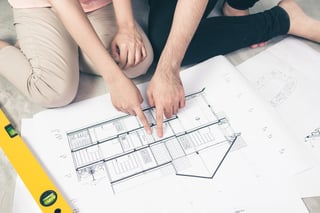 One of the most frustrating parts of looking at house plans online, in a plan book, in a magazine, or wherever, is that looking at a house plan on a flat screen or piece of paper won’t tell you how the house is going to look or feel in real life. You might love the way a plan is laid out or how the front elevation looks, but you probably still have nagging questions.
One of the most frustrating parts of looking at house plans online, in a plan book, in a magazine, or wherever, is that looking at a house plan on a flat screen or piece of paper won’t tell you how the house is going to look or feel in real life. You might love the way a plan is laid out or how the front elevation looks, but you probably still have nagging questions.Is that family room big enough for my furniture? Is that dining room really big enough for our dinner table and chairs? Will the kids be able to fit all their stuff in that bedroom? Will my truck fit into that garage along with the mower and the four-wheeler?
These are all legitimate questions. While you might not ever get to see that online house plan in real life, there are some ways to answer some of those nagging questions by doing a little homework.
Your house plan homework
Here’s how to determine if the house plans you like will fit your family.
Gather up a few items: a pencil (not a pen), a pad of paper, a tape measure, and a ruler. Take a couple of Sunday afternoons and find some open houses in neighborhoods that seem to be in your price range. Walk through those houses with the purpose of building a sense of room sizes and overall scale. You might get some weird looks from the Realtors and other people touring the homes, but sometimes that just adds to the fun
Measure family rooms, dining rooms, bedrooms, kitchens, garages, and whatever else is important to you. Write down the dimensions. Using your ruler, sketch the rooms on your paper using a scale that will allow you to draw the rooms proportionally. I like to use one-quarter inch on the ruler to represent one foot in real life, if I can get the dimension to fit on the paper—otherwise, shrink it to one-eighth inch per foot.
Pull out those house plans you like and compare what you saw in real life to the rooms in the house plans. By doing this, you'll get a feel for what those dimensions on the house plans look like in real life.
One family’s too-small dining room
I once built a home for a family who had chosen a house plan from a book and really liked the way the home would look from the front. In fact, they fell in love with it. One room that was critical to them was the dining room—they enjoyed hosting extended family for holidays and other occasions and wanted to share their table with everyone, something they couldn't do in their old house.
When visiting open houses and measuring their proposed dining table at the furniture store (with people seated around it) they realized the dining room in their dream house plan wasn't big enough. Since making rooms bigger is much easier on paper than in real life, we helped them modify the house plan and create the space they needed to preserve the look they had fallen in love with.
By doing their homework, they discovered the fatal flaw and were able to correct it.
If you're ready for more detail, read this comprehensive article on how to find the perfect house plan.
There are lots of ways to visualize what a house plan is going to look and feel like in real life. There are also lots of possibilities when designing a plan from scratch. The key is to get a feel for scale by training yourself to mentally translate the flat floor plan into real life through real-world examples.
For more in-depth help on how to get the right floor plan for your needs and wants, download this free guide on Three Steps to the Perfect Floor Plan.
For more information, read this article on the overall process of building a home on your land.
